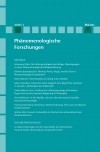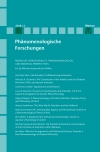Abstracts
Philip Flock: Das Problem der „großen Gegenwart“. Marc Richirs Kritik am historischen Apriori Husserls am Leitfaden des Ursprungs der Geometrie:
The article analyzes the commentaryof the Belgian phenomenologist MarcRichir on the Beilage III of the Crisis of Edmund Husserl. In this famous historico-philosophical treatise Husserl examines the eidetic dependencies of ideality, language and history from a genetic perspective. The model of ‘Ur-’, ‘Nach-’, and ‘Endstiftung’ is intended to bring to light a transcendental insight into the ‘inner historicity’ of the objects of knowledge which corresponds with an epistemological model of history. Marc Richir’s thesis is that in this field of complex relations there are several confusions of phenomenological and actually symbolic aspects. To be able to name and criticize these implicit changes of register, it is necessary to elaborate on Richir’s own transcendental-phenomenological approach: the phenomenological architectonics of the phenomenological and symbolic field. This architectonics inserts into the Husserlian difference of intentional and formal-syntactic thinking, a symbolic field in the sense of ‘languagephenomenon’.
Till Grohmann: Für eine Onto-Ästhetik des Autismus. Synästhesien als Phänomene leiblicher Resonanz
The present paper analyses synesthesia in autism (ASD) and neurotypical experience. The way synesthesia has been interpreted within the history of phenomenology and psychopathology should prepare a philosophical access to autism and its subjective condition. The paper draws on the basic assumption that synesthesia reveals the presence of sensible networks and crossmodal connections beneath the framework of objective reality. Synesthesia, it is argued, confronts us with a specific dimension of the world beneath the essential structures of a material apriori, as it is elaborated within husserlian phenomenology. Experience in autism has close connections with such an alternative ontological setting. Asa matter of fact, autistic self-advocates often describe moments of a deep immersion into sensible experience, in which different sensorial events come to ‘resonate’ with one another. Resonance is thus interpreted as a fundamental ontological connector within an experiential framework that is not subjected to abstract concepts and causal thinking.
Rolf Kühn: ,Vitalismus‘ und reine Potenzialität bei Michel Henry. Zur gegenwärtigen Rezeption in der Henry-Forschung auf dem Hintergrund radikalphänomenologischer Leibanalyse:
The recent interpretation of Michel Henry’s thought as a ‘phenomenological vitalism’ raises fundamental questions regarding the reception of his phenomenology. The issue raised, however, is not primarily about radical phenomenology being inspired (or not) by more or less vitalistic philosophies like those of Maine de Biran, Schopenhauer, Nietzsche, and even Freud, rather it concerns the ‘how’ of purely immanent appearing in affect and force understood as immediate corporeality. Does the latter, being original affectivity, require temporality in order to free the affect from its passivity (Passibilit%t) and, thus, in order to enable action? This, however, would lead to an impossible intentional gap or difference within the original phenomenality of life itself. As an alternative, flesh can be seen as a potentiality, inwhich the concrete transcendental possibility and the phenomenological power of appearing as ‘I can’ are already united prior to any formal exercise of freedom. Such inquiry into the reception of the phenomenology of life provides at the same time a framework for the contemporary phenomenological debate.
Ronny Miron: The Duality of the I in the Thinking of Hedwig Conrad-Martius:
This article presents the dualist perception of the ‘I’ of the woman phenomenologist, Hedwig Conrad-Martius (1880–1966) as a radical attempt to respond critically to Husserl’s turn towards transcendentalism. Conrad-Martius’s peculiar view of the I (ichhaftes Sein) appears as a remarkable refutation of one of the widespread criticisms of the phenomenological realism contemporary with Edmund Husserl regarding the lack of discussion of the issue of the ego or the I. My main argument is that the dualism not only signifies the structure of the I inHCM’s philosophy but also provides the essential framework for its phenomenological deciphering, in which it transpires as a genuine philosophical problem that as such is unresolved.
Takuya Nakamura: Die Phänomenologie des Unbewussten als Grenzproblem bei Husserl:
In this paper, I attempt to elucidate Husserl’s later phenomenological approach to the unconscious as a limit problem of phenomenology. Husserl had encountered the kind of problem as the unconscious earlier on and it continued to come up throughout his work. There are references to the unconscious in Ideas II and in the Analyses Concerning Passive Synthesis, and even in early lectures. Nonetheless, the unconscious as a severe problem of Husserl’s phenomenology emerged only in his mature phase. In this paper, I first discuss how Husserl treats the unconscious in relation to affection in Analyses Concerning Passive Synthesis, in order to shed light on the process of how the unconscious is problematized in phenomenology. Then, I rely on his later manuscripts on the unconscious in Husserliana XLII, where Husserl deals with the unconscious in relation to waking and sleeping. At the end, I explain how Husserl explores the multi-layered structure of consciousness as a result of his treatment of the unconscious as limit problem of phenomenology.
Mathias Obert: Erfahrungen in japanischen Gärten: Eine ästhetisch-phänomenologische Skizze:
This paper tries to elucidate phenomena relied to experiences actually made in Japanese gardens. By means of phenomenological description and analysis, it aims at clarifying, from the stance of aesthetics and philosophy, how those specific experiences should be understood, how exactly intuition and experience constitute themselves hereby. Besides discussing questions concerning the naturalness and strangeness of reality, this article mainly deals with basic ideas of phenomenology, such as horizon, affection, tonality, responsivity, genesis of phenomena, as well as temporality. This endeavour narrowly intertwines concrete analysis of phenomena with critical reflection on how to do phenomenology, the author being convinced that thinking on conditions of phenomenality may become meaningful only when staying in close touch with the concrete experiencing of phenomena themselves. Thus, this paper aims at contributing to a phenomenological thinking rooted in aesthetic experience and the body.
Claude Romano: L’ipséité et non le moi : promesses et potentialités d’un concept:
Does Heidegger really have a “theory of the self ” in the same way as, say, Descartes, Locke or Husserl? This is what has often been concluded bymany interpreters of Being and Time, and it is that view that this paper challenges. Heidegger not only rejects the supposition of a substantial ego, along the lines of Descartes’ conception, but he also repudiates, more generally, any “self ” understood as a present-at-hand being, an inner core of Dasein, as he insists on the intrinsic connection between the “egologies,” from Descartes to Husserl, and “traditional ontology”. The fundamental-ontological approach of Selbstheit and Selbstsein, that is, ipseity and Beingoneself, constitutes rather a complete paradigm-shift in the history of Modern philosophy, and a complete break with the egologies as a whole, since both concepts refer only to “ways of being” or “ways of existing” of Dasein. Insofar as its novelty is acknowledged, the concept of ipseity may thus also be taken as an heuristic tool to investigate the history of philosophy, and especially to reformulate in slightly different terms the problem that was at the centre of the courses on « subjectivity and truth » of the late Foucault.
Stefan W. Schmidt: Der Verlust des Ortes für das geographische Subjekt. Topophänomenologische Analysen des nostalgischen Gedächtnisses:
In my paper, I analyse the aspects of nostalgia as a form of lived bodily memory and show how the spatiotemporality of the present is ‘haunted’ by the superimposed appearance of the past. Nostalgia is a movement of seeping returns. We find ourselves overwhelmed by the desire of a place that is imprinted in our bodies. To become acquainted with a place takes time. And later on, it is this time that comes back to us when we desire this particular place. In our desire for a place, we also desire a certain time, and we become familiar with both, time and place. An essential part of the structure of nostalgia is the distinctive fixation, qualitatively positive or negative, of an image that binds the self to a place and time. The past transpires into the present, and nostalgia shows how we experience time through our lived bodies.
Nóra Szegedi: The Renewal of Phenomenology in France: Levinas and Marion
Starting from Hans-Dieter Gondek’s and L/szl7 Tengelyi’s statement concerning the recent development of French phenomenology, I examine the relation between Marion’s phenomenology of givenness and Levinas’ ethics. Focusing on their common concept of the call (appeal), I demonstrate, first, that Marion’s general concept of the phenomenon is based on Levinas’ idea of the manifestation of the Other, which he deprives of its original ethical meaning. In the second part I criticize Marion’s anti-ethical reading of Levinas, while trying to give a tenable interpretation of the meaning of the ethical. Taking into consideration the results of the second section, in the third part, I look into the possibility of a different general phenomenology starting from Levinas’ ethics. By this rather sketchy idea I intend to provide a possible alternative to Marion’s general phenomenology of givenness, which maintains the privilege of the Other and, consequently, the primacy of ethics.
Jean-Daniel Thumser: L’animalité et l’anomalité comme figures-limites de la phénoménologie
The purpose of the article is to show how the questions of anomality and animality belong together in phenomenology. The figure of the human animal serves as the guideline of the study, namely the figure of a person who is not considered as similar to myself in the frame of a Husserlian characterization of normality. Husserl’s thinking is analyzed with respect to the problem of an intersubjective co-constitution of a common world. It is shown that Husserl only accepts animality and anomality within the restrictive perspective of a so-called normal humanity, that of the adult man, healthy, reasonable and European. However, he constantly strives to include the anomality and animality into humanity as well, an intention that distinguishes him from Heidegger. Heidegger radicalized the question with respect to race, which serves him as a guideline for thinking the very own of the human being. Defending a thinking of exclusion, Heidegger refuses to animals as well as to anomals all right of citizenship in the community of human beings. The article ends by proposing to overcome this duality between an inclusive thinking and an exclusive thinking.

















